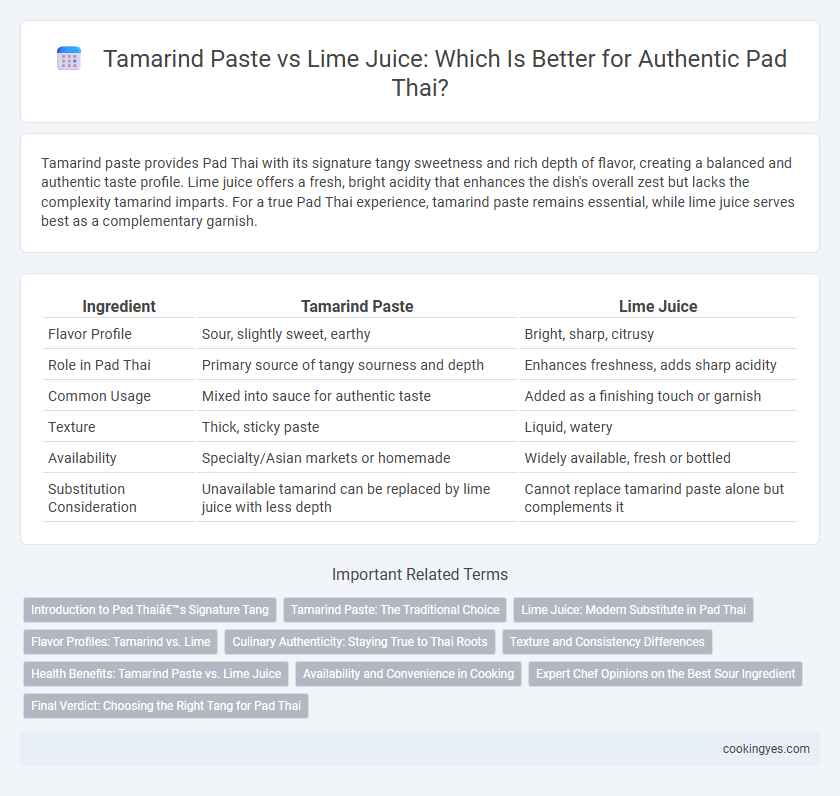Tamarind paste provides Pad Thai with its signature tangy sweetness and rich depth of flavor, creating a balanced and authentic taste profile. Lime juice offers a fresh, bright acidity that enhances the dish's overall zest but lacks the complexity tamarind imparts. For a true Pad Thai experience, tamarind paste remains essential, while lime juice serves best as a complementary garnish.
Table of Comparison
| Ingredient | Tamarind Paste | Lime Juice |
|---|---|---|
| Flavor Profile | Sour, slightly sweet, earthy | Bright, sharp, citrusy |
| Role in Pad Thai | Primary source of tangy sourness and depth | Enhances freshness, adds sharp acidity |
| Common Usage | Mixed into sauce for authentic taste | Added as a finishing touch or garnish |
| Texture | Thick, sticky paste | Liquid, watery |
| Availability | Specialty/Asian markets or homemade | Widely available, fresh or bottled |
| Substitution Consideration | Unavailable tamarind can be replaced by lime juice with less depth | Cannot replace tamarind paste alone but complements it |
Introduction to Pad Thai’s Signature Tang
Pad Thai's signature tang traditionally comes from tamarind paste, which imparts a rich, slightly sweet sourness essential to the dish's authentic flavor profile. Lime juice can provide fresh acidity but lacks the depth and subtle fruity undertones that tamarind offers, making tamarind paste the preferred ingredient for achieving genuine Pad Thai taste. Using tamarind paste balances the savory, sweet, and spicy elements, creating the iconic harmony that defines this classic Thai street food.
Tamarind Paste: The Traditional Choice
Tamarind paste is the traditional and essential ingredient that gives Pad Thai its signature tangy and slightly sweet flavor, distinguishing the dish from other stir-fries. Its unique sourness enhances the overall balance of the recipe, complementing the sweetness of palm sugar and the saltiness of fish sauce. While lime juice can add brightness, tamarind paste provides depth and authenticity that are crucial for an authentic Pad Thai experience.
Lime Juice: Modern Substitute in Pad Thai
Lime juice serves as a modern substitute in Pad Thai for tamarind paste, offering a fresh, citrusy flavor that brightens the dish while providing acidity to balance sweetness and saltiness. Unlike tamarind paste, lime juice is more readily available and enhances the overall tanginess without overpowering other ingredients. Its use caters to contemporary palates and simplifies preparation without compromising the signature taste of Pad Thai.
Flavor Profiles: Tamarind vs. Lime
Tamarind paste provides Pad Thai with a deep, tangy, and slightly sweet flavor that forms the dish's traditional sour base, offering complexity and a rich umami undertone. Lime juice contributes a bright, sharp acidity and fresh citrus aroma that enhances the dish's lightness and balances sweetness with crisp, zesty notes. The choice between tamarind paste and lime juice significantly influences the flavor profile, with tamarind creating a more rounded sourness and lime delivering vibrant, refreshing tartness.
Culinary Authenticity: Staying True to Thai Roots
Tamarind paste is essential for authentic Pad Thai, providing the distinct tangy and slightly sweet flavor that defines traditional Thai cuisine. Lime juice, while adding brightness, lacks the complex depth and subtle earthiness that tamarind offers, making it a less authentic substitute. Using tamarind paste preserves the dish's genuine taste, aligning with time-honored Thai culinary practices.
Texture and Consistency Differences
Tamarind paste provides a thick, smooth texture that enhances the sauce's viscosity in Pad Thai, creating a rich and cohesive consistency that clings well to the noodles. Lime juice, being more liquid and acidic, results in a thinner, sharper sauce that adds brightness but lacks the binding quality tamarind paste offers. The use of tamarind paste contributes to a balanced, dense sauce texture essential for authentic Pad Thai, while lime juice primarily serves as a finishing touch for tanginess without altering the overall consistency.
Health Benefits: Tamarind Paste vs. Lime Juice
Tamarind paste in Pad Thai offers rich antioxidants and essential vitamins like vitamin C, which support immune health and improve digestion. Lime juice provides a potent source of vitamin C and flavonoids that boost antioxidant defenses and promote heart health. Both ingredients contribute beneficial nutrients, but tamarind paste adds more dietary fiber, enhancing gut health compared to lime juice.
Availability and Convenience in Cooking
Tamarind paste, a traditional ingredient in Pad Thai, offers a unique tangy sweetness but may be harder to find in regular grocery stores compared to lime juice, which is widely available and convenient for quick use. Lime juice provides a bright, citrusy flavor and can be easily added fresh or bottled, making it a practical substitute when tamarind paste is unavailable. While tamarind paste delivers authentic depth, lime juice enhances versatility and accessibility in home cooking for Pad Thai.
Expert Chef Opinions on the Best Sour Ingredient
Expert chefs often favor tamarind paste for Pad Thai due to its complex, tangy flavor that balances sweetness and umami, creating an authentic taste. Lime juice is appreciated for its bright, fresh acidity but is typically used as a finishing touch rather than a primary sour ingredient. Many culinary experts agree that tamarind paste provides the signature depth essential to traditional Pad Thai, while lime juice enhances the dish's vibrant final flavor.
Final Verdict: Choosing the Right Tang for Pad Thai
Tamarind paste delivers a rich, complex tang essential for authentic Pad Thai, balancing sweetness and sourness with depth that lime juice cannot replicate. Lime juice offers a bright, sharp acidity, enhancing freshness but lacks the fermented, fruity undertones integral to traditional flavors. For the perfect Pad Thai tang, tamarind paste remains the preferred choice, providing an unmistakable, well-rounded sour note that defines the dish.
Tamarind paste vs lime juice for Pad Thai Infographic

 cookingyes.com
cookingyes.com